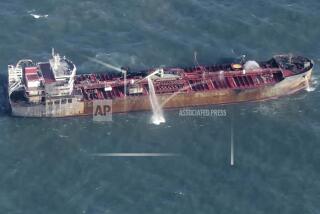Spectacular Blasts Ignite Oil Aboard Grounded Ship
- Share via
SEATTLE — Navy bomb experts set off a spectacular series of explosions late Thursday, starting a fire that officials hoped would burn 400,000 gallons of fuel in a freighter that ran aground in Coos Bay, Ore.
The fire, which could be seen as far as 25 miles along the Oregon coast, was a last-ditch effort to save beaches from a potentially devastating oil spill that could foul the shoreline and threaten endangered species.
The 5:40 p.m. operation “was very successful. We’ve got a good hot fire going. There’s a lot of smoke and it went north along the beach, away from any populated areas,” said Alan Hoffmeister, a spokesman at the Coos Bay command center.
Days before the explosion, tourists began flocking to view the crippled New Carissa, snarling traffic and filling motels in the fishing and lumber town of 16,000. But frightened residents flooded the police and fire departments with phone calls, asking whether they should evacuate.
“You think napalm [which was used to ignite the fuel], and you think of Vietnam and half the country being burned up,” said Joyce Jansen, a City Hall secretary. “People were afraid for their children.”
Police Chief Chuck Knight said the Navy had assured city officials that there was no threat to the community.
“It is incredible, the rumors that are going around,” he said.
More than 100 people called the police station Wednesday. Some wondered whether they should flee to Roseburg, 80 miles inland. Others wondered whether their children were in danger of being hit by flying debris as they walked home from school, Knight said.
The fears were compounded, the police chief said, by the Navy and Coast Guard’s failure to notify city officials Wednesday of their plan to set the ship’s fuel on fire using explosives.
“We learned about it from the television,” Knight said.
Hoffmeister said there was no time to notify local officials of that first attempt to set the ship’s fuel ablaze, which ended unsuccessfully.
The Navy and the Coast Guard decided Wednesday to try to burn the oil on the 639-foot freighter because a severe storm was expected to blow into the bay Wednesday night or Thursday morning, Hoffmeister said. They feared that the freighter--which is Panamanian-owned and Japanese-operated--might break in half and spill its contents on Coos Bay’s beaches.
Navy bomb experts used grenades and buckets of gasoline in their attempt Wednesday to ignite the ship’s heavy, tar-like bunker fuel used to power the ship’s engines. Eight hours of preparation ended in a quick flare-out after the grenades failed to penetrate the half-inch to three-quarter-inch-thick steel fuel tanks, Hoffmeister said.
“The charges were a little too conservative,” he said.
After the storm failed to materialize, the bomb experts began laying large explosive charges on the ship Thursday morning. In the afternoon, they put more than 600 gallons of highly flammable napalm gel over the oil. Shortly after sunset, the experts left the ship and detonated the explosives by remote control, cracking open the fuel tanks and letting the oil flood the cargo hold. Then they detonated the napalm with C-4 plastic explosives.
The result was expected to be the biggest planned burn of a waterborne oil spill in U.S. history. Experts say a successful burn could eliminate 90% of the oil, far more than could be recovered if the fuel makes it to shore.
Much is at stake, even though the oil that could spill out of the Carissa is a minuscule amount compared with the 11 million gallons that gushed from the Exxon Valdez’s fractured hull in March 1989, fouling Alaska’s Prince William Sound.
The New Carissa hit a sand bar Feb. 4 just 150 yards off the Oregon Dunes National Recreation Area. The freighter had been on its way to pick up a load of wood chips--used in paper manufacturing--when it began drifting in high seas and ran aground.
Coos Bay, the largest bay between Portland and San Francisco, is Oregon’s most biologically rich estuary. It is the favored nesting ground of the Western snowy plover, a bird that is on the federal endangered species list.
The bay is a prime fishing ground for south-central Oregon’s $24-million-a-year Dungeness crab industry, and is home to seals, sea lions, otters and many species of birds and shellfish.
In Washington, 180 nautical miles north of the crippled ship, officials were cleaning driftwood and kelp off beaches and bracing for tides to carry the oil to their shores in case the burn failed.
The crippled freighter began leaking Monday. Globs of oil have washed ashore as much as seven miles north of the tanker and three miles south of it. About 300 workers have been hired by the ship’s owners to start cleaning the beach.
By Thursday, two dead birds believed to have been killed by the oil had been found on shore, Hoffmeister said. Wildlife experts were standing by with a mobile medical center in case others need treatment.
The National Oceanic and Atmospheric Administration said 50 to 100 miles of the Oregon coast could have been affected if all the oil had spilled from the ship before it could be burned.
The Navy expects the fuel to burn for several days, gutting the steel ship. The hull then would have to be carved up and hauled away.
More to Read
Sign up for Essential California
The most important California stories and recommendations in your inbox every morning.
You may occasionally receive promotional content from the Los Angeles Times.












